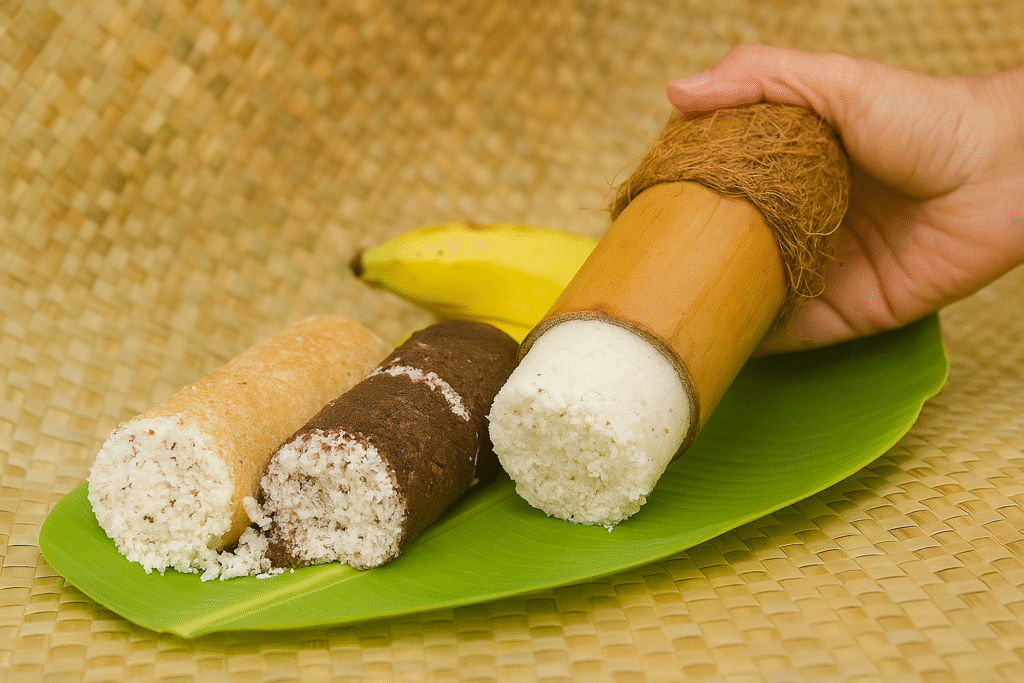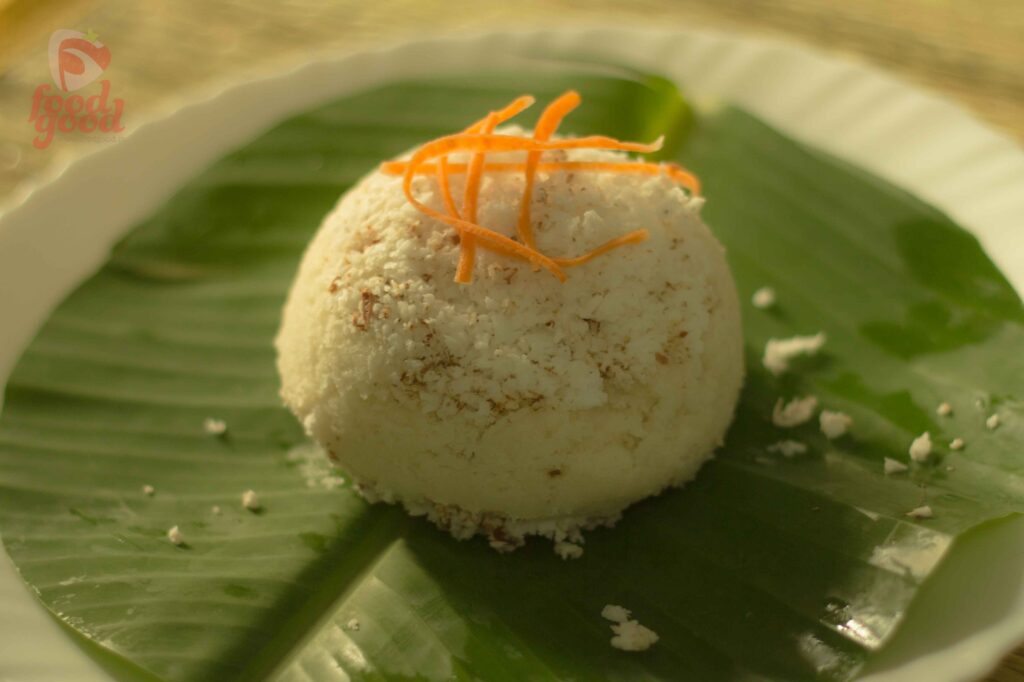Puttu is a quintessential breakfast item in the southern Indian state of Kerala, loved for its simplicity, flavor, and nutritional value. Made primarily with coarsely ground rice flour and grated coconut, and steamed in a cylindrical mold, Puttu has been a part of the Malabar culinary culture for centuries.
This humble, tube-shaped steamed cake is not only a staple in Kerala households but also enjoys popularity in parts of Tamil Nadu, Sri Lanka, and even Southeast Asia and Africa, going by different names and regional adaptations.
Origin and History
The term “Puttu” is believed to have originated from the Dravidian word for “portioned” or “parted.” While the exact historical origins are not clearly documented, Puttu likely evolved as a traditional steamed food in coastal Kerala, where coconut and rice are abundant. It has been a part of Kerala’s food culture for at least a few hundred years, especially among the agrarian communities.
Puttu was traditionally prepared in bamboo logs, which imparted a distinct aroma. Today, the metal cylindrical “puttu kutti” or “puttu maker” is more commonly used.
Names and Regional Variants
Puttu goes by different names and slightly varied forms in many regions:
| Region/Country | Local Name | Notes |
|---|---|---|
| Kerala | Puttu | Traditional cylindrical or dome-shaped variant |
| Tamil Nadu | Pittu / Arisi Puttu | Often sweetened and served as a dessert |
| Sri Lanka | Pittu | Made with red rice flour; eaten with coconut milk |
| Malaysia & Singapore | Puttu Mayam / Putu Bambu | Often sweet; served with jaggery or palm sugar |
| Indonesia | Putu | Typically filled with palm sugar and steamed in banana leaves |
| Mauritius | Poutou | Steamed rice dessert of Tamil origin |
Variations: The Diverse World of Puttu
The basic premise of Puttu-steamed rice flour and coconut-allows for a surprising array of variations, reflecting regional preferences and the creativity of home cooks:

- Chemba Puttu (Red Rice Puttu): This is perhaps the most common and traditional variation, made from roasted red rice flour, which gives it a slightly coarser texture and a distinct nutty flavor. It’s often considered healthier.
- Vella Puttu (White Rice Puttu): Made from white rice flour, this version is softer and lighter in texture. It’s equally popular, especially for those who prefer a less rustic feel.
- Gothambu Puttu (Wheat Puttu): A healthier alternative, this variation uses wheat flour instead of rice flour. It’s denser but equally delicious, often preferred by those looking to reduce rice consumption.
- Rava Puttu (Semolina Puttu): Made with semolina (rava), this Puttu has a different texture, often slightly granular. It’s a quicker version to prepare.
- Puttu with Savory Fillings: While traditionally made with coconut layers, some innovative variations include savory fillings like minced meat (beef or chicken), prawns, or even vegetables, creating a more wholesome meal in itself.
- Puttu with Sweet Fillings: Sweet versions incorporate jaggery, plantains, or even jackfruit pulp within the layers, turning Puttu into a dessert or a sweet snack.
The Perfect Companions: Curries and Sides for Puttu
Puttu’s mild flavor makes it an excellent canvas for a variety of accompaniments. The curries served alongside Puttu are just as crucial to the overall experience:
- Kadala Curry (Black Chickpea Curry): This is the quintessential partner for Puttu. A thick, flavorful curry made with black chickpeas, roasted coconut, and a blend of aromatic spices, Kadala Curry perfectly complements the subtle taste of Puttu. The gravy coats the Puttu, creating a delightful mouthful.
- Cherupayar Curry (Green Gram Curry): A lighter, yet equally delicious option, this curry is made with green gram (moong dal) cooked with coconut milk and mild spices. It offers a gentle contrast to the Puttu.
- Parippu Curry (Dal Curry): A simple and comforting lentil curry, often made with toor dal or moong dal, tempered with mustard seeds and curry leaves. It’s a staple in many Kerala households and pairs wonderfully with Puttu.
- Pazham (Ripe Banana): A traditional and incredibly popular sweet accompaniment. Sliced ripe bananas, often Nendran Pazham (a variety of plantain), are mashed with the Puttu or eaten alongside, providing a natural sweetness that balances the savory curries. [Insert a reference pic of Puttu with Sliced Bananas here]
- Pappadam (Fried Lentil Cracker): The crispy, salty crunch of fried pappadam adds a delightful textural contrast to the soft Puttu.
- Fish Curry: In coastal areas, Puttu is often enjoyed with a spicy and tangy fish curry, particularly a traditional Kerala style “Meen Curry” made with coconut milk and kudampuli (Garcinia cambogia) for tanginess.
- Beef Curry/Chicken Curry: For non-vegetarian lovers, Puttu with a rich and flavorful beef or chicken curry is a hearty and satisfying breakfast option.
Puttu is more than just a dish; it’s a cultural symbol, a testament to Kerala’s rich culinary heritage. Its simplicity, versatility, and the comforting feeling it evokes have ensured its enduring popularity, not just within Kerala but across the globe, bringing a taste of the Malabar coast to every table. So, the next time you’re looking for a wholesome and authentic breakfast experience, reach for a plate of steaming hot Puttu – you won’t be disappointed.
Kerala Puttu / Pittu
Description
Puttu principally consists of coarsely ground rice, grated coconut, little salt and water. It is often spiced with cumin, but may have other spices. The Sri Lankan variant is usually made with wheat flour or red rice flour without cumin, whereas the Bhatkal recipes have plain coconut or masala variant made with mutton or shrimp flavoured grated coconut.
In Bangladesh, the outside is made of a mixture of rice flour and ground moong dal, while the filling is a mixture of coconut flakes and a type of caramelized sugar that is similar to dulce de leche
How to Make Puttu (Pittu)
To make Puttu, you need a special vessel called a Puttu Steamer, which consists of two parts:
- Puttukudam (Steamer base): If you don’t have a traditional steamer, you can use a pressure cooker without the weight.
- Puttukutty: A long cylindrical steel pipe with a perforated disc (jali) at the bottom and a lid on top.
In this recipe, we are using a Chiratta Puttu Maker instead of the traditional Puttukutty.
Ingredients
Instructions
-
Fill the Puttukudam (steamer) or pressure cooker halfway with water. Let it boil until steam starts to come out.
-
In a bowl, take 1 cup of rice flour (Puttupodi).
-
Add the required amount of salt and cumin seeds, and mix well using your hands.
-
Sprinkle water little by little, and mix with your fingertips until the mixture forms moist crumbs.
-
Some types of rice flour may require a 1:1 ratio of flour and water.
-
In the Puttukutty (or Chiratta Puttu Maker), place the perforated disc (jali) at the bottom.
-
Add a layer of grated coconut and spread it evenly.
-
Fill half of the Puttukutty with the rice flour mixture, then add another layer of grated coconut.
-
Repeat the layering — rice flour, then coconut — until the mold is filled. Finish with a final layer of coconut on top.
-
Close the lid and place the Puttukutty over the steaming Puttukudam.
-
Steam until hot steam starts to come out from the top.
-
Switch off the flame and let it rest for 2–3 minutes.
-
Remove the Puttukutty from the steamer and use a stick or spoon to gently push out the steamed Puttu.


